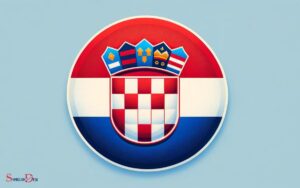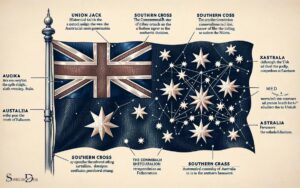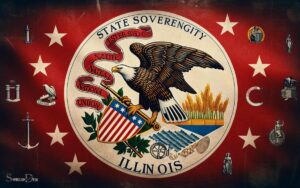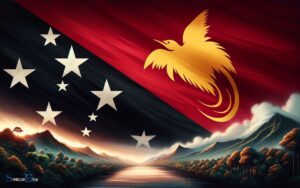What Does the Symbol on the Nicaraguan Flag Mean? Equality!
The symbol on the Nicaraguan flag consists of the Coat of Arms of Nicaragua, which features a triangle that represents equality, a rainbow symbolizing peace, five volcanoes for the five member states of the United Provinces of Central America.
The Phrygian cap symbolizing liberty, and the words ‘República de Nicaragua’ on top and ‘América Central’ on the bottom.
The Nicaraguan flag’s central symbol, the Coat of Arms, is rich in symbolism and steeped in the history of the country.
Each element within the Coat of Arms has a specific meaning:
- Triangle: Stands for equality among all people.
- Rainbow: A universal symbol of peace.
- Five Volcanoes: Represent the unity and brotherhood of the five original Central American countries.
- Phrygian Cap: A classical emblem of freedom and the struggle for independence.
- The words ‘República de Nicaragua – América Central’: Highlight the country’s full name and its geographical location in Central America.
For example, the five volcanoes are significant because they correspond to the five nations of the former Federal Republic of Central America: Nicaragua, El Salvador, Costa Rica, Honduras, and Guatemala.
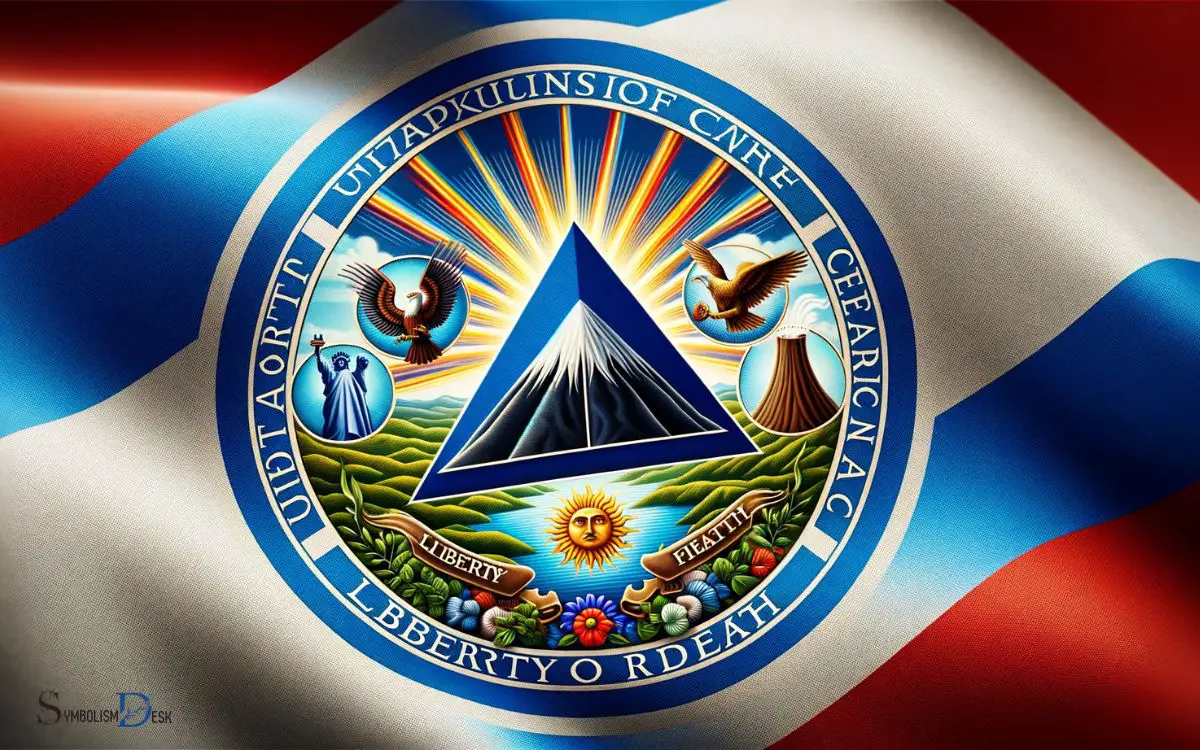
Key Takeaway
7 Symbols Meanings of the Nicaraguan Flag
| Symbol | Meaning |
|---|---|
| Blue Stripes | Represent the Pacific Ocean and Caribbean Sea; also symbolize the Nicaraguan’s adherence to liberty |
| White Stripe | Stands for the land between the two bodies of water and symbolizes purity and nationalism |
| Coat of Arms | At the center with five volcanoes in the middle, represents the unity and brotherhood of all five Central American countries |
| Phrygian Cap | Symbolizes liberty |
| Rainbow | Symbolizes peace |
| Five Volcanoes | Signify the five members of the federation: Honduras, El Salvador, Costa Rica, Nicaragua, and Guatemala |
| Cap of Liberty & Rays of Sun | Signify the freedom and sovereignty of the Nicaraguan nation |
Historical Origins of the Symbol
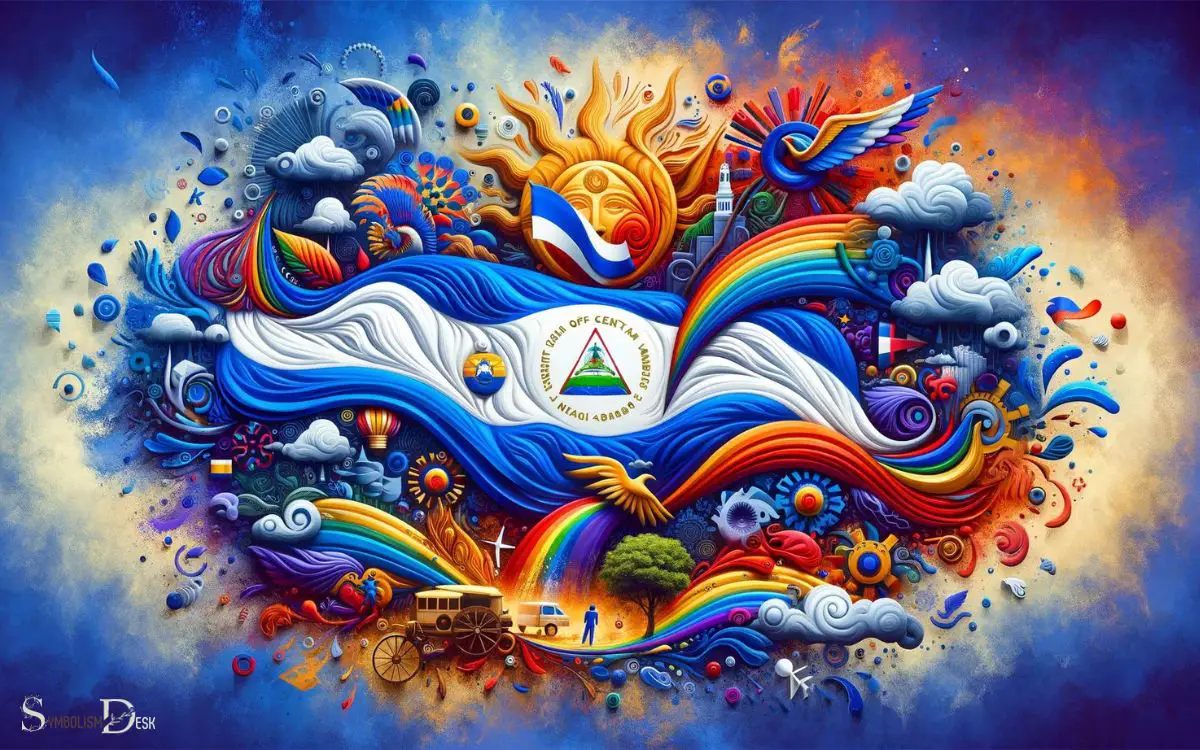
The historical origins of the symbol on the Nicaraguan flag can be traced back to the indigenous cultures of the region.
The central emblem on the flag is derived from the ancient civilizations that inhabited the area, particularly the indigenous people of the Nahua and Chorotega tribes.
The five volcanoes depicted on the flag are representative of the original five Central American provinces.
The triangle symbolizes equality, fraternity, and liberty, principles that are integral to the nation’s identity. The rainbow in the triangle represents the bright future and the hope of the Nicaraguan people.
This symbol has evolved over time, embodying the rich history and cultural heritage of Nicaragua. Understanding the historical significance of the flag’s symbol provides insight into the country’s deep-rooted traditions and values.
Evolution of the Symbol Over Time
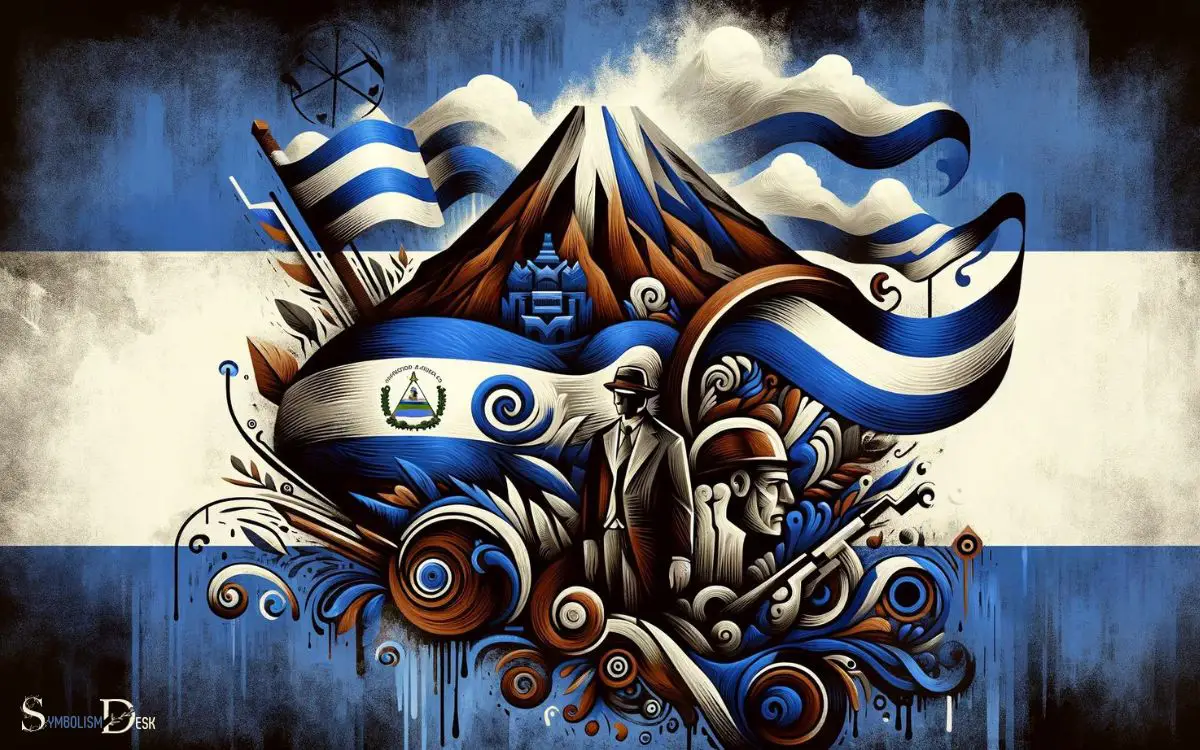
The symbol on the Nicaraguan flag has undergone significant evolution over time, reflecting the dynamic cultural and historical changes that have shaped the nation’s identity.
The evolution of the symbol has been a testament to Nicaragua’s rich history and the resilience of its people.
This evolution has included embracing indigenous influences to honor the country’s native roots. It has also involved incorporating symbols of resistance and liberation to commemorate Nicaragua’s struggle for independence.
Additionally, the symbol has adapted to reflect the values of unity and solidarity that are integral to the nation’s ethos.
Furthermore, the symbol has evolved to encompass modern ideals and aspirations, symbolizing Nicaragua’s forward trajectory.
This ongoing transformation of the symbol on the Nicaraguan flag serves as a visual narrative of the nation’s journey, resonating with the hearts of its people and capturing the spirit of Nicaragua’s past, present, and future.
Cultural Significance and Interpretations
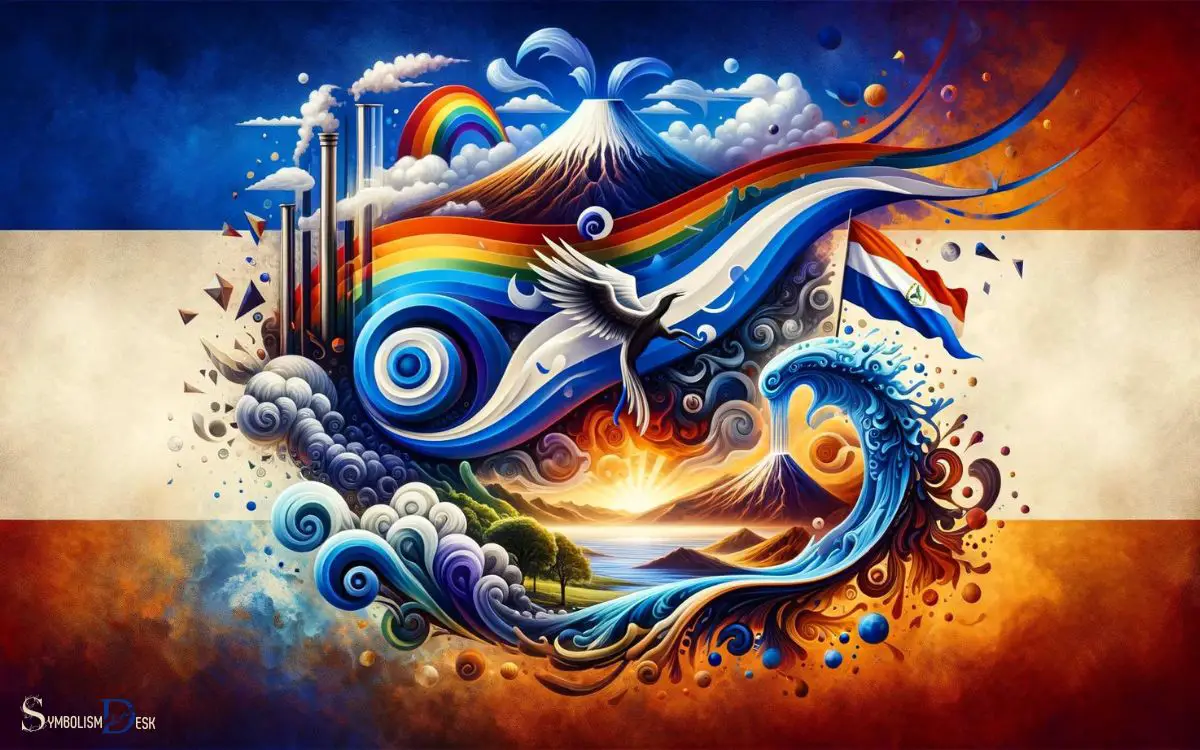
Reflecting the diverse influences that have shaped Nicaragua’s cultural identity, the symbol on the Nicaraguan flag holds deep cultural significance and invites various interpretations.
The flag’s central symbol is the country’s national coat of arms, depicting a rainbow, five volcanoes, and a Phrygian cap.
The rainbow is often seen as a symbol of peace and hope, representing the diverse indigenous groups and ethnicities within Nicaragua.
The five volcanoes are said to represent the five Central American countries, emphasizing unity and solidarity within the region.
The Phrygian cap, a symbol of freedom and the fight against oppression, reflects Nicaragua’s history of resistance against colonialism and imperialism.
Symbolism in Nicaraguan Society
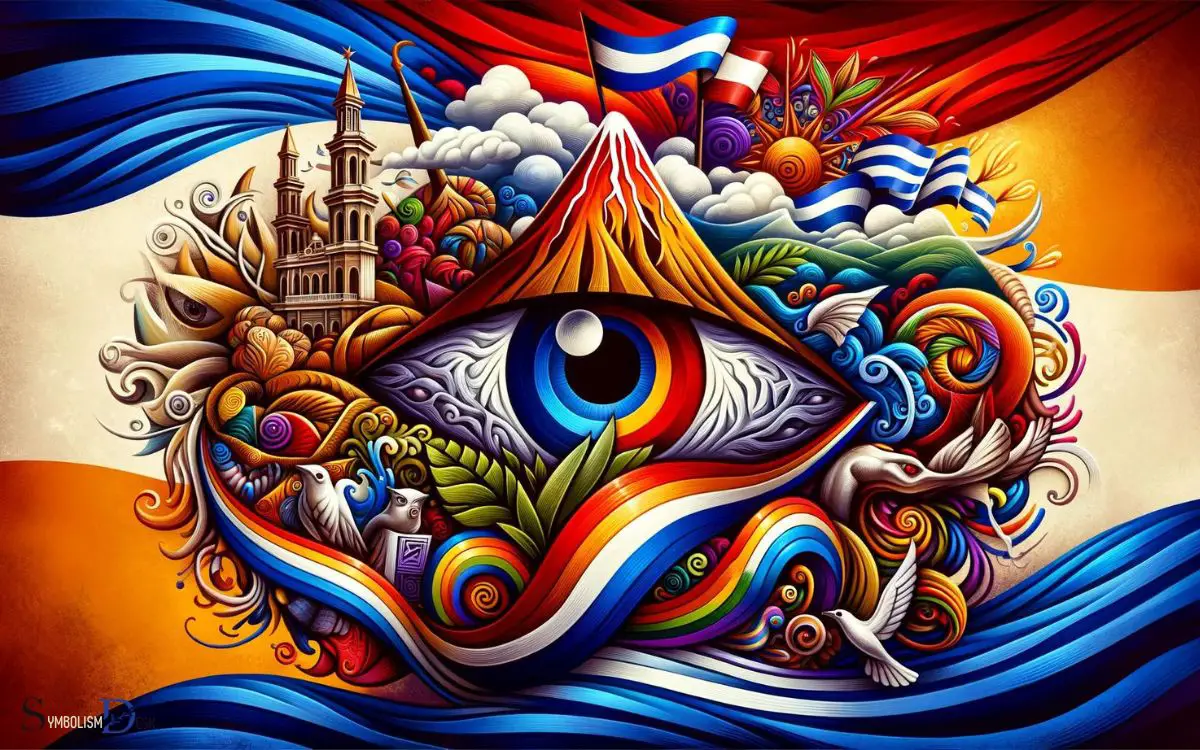
Illustrating the diverse influences that have shaped Nicaraguan society, the flag’s central symbol holds deep cultural significance and invites various interpretations.
The symbolism in Nicaraguan society can be understood through the following:
- Historical Resilience: The flag’s symbol reflects the country’s history of resistance and perseverance, resonating with the struggles and triumphs of the Nicaraguan people.
- Unity and Diversity: It represents the unity of different ethnic groups and the diversity of cultural traditions within the nation, fostering a sense of inclusivity and mutual respect.
- National Pride: The symbol instills a sense of pride and patriotism, evoking strong emotions and a deep connection to the country’s heritage and values.
- Aspirations for the Future: It embodies the aspirations for progress and prosperity, serving as a reminder of the nation’s potential and the collective vision for the future.
Understanding the symbolism in Nicaraguan society provides insight into the impact of the symbol on national identity.
Impact of the Symbol on National Identity
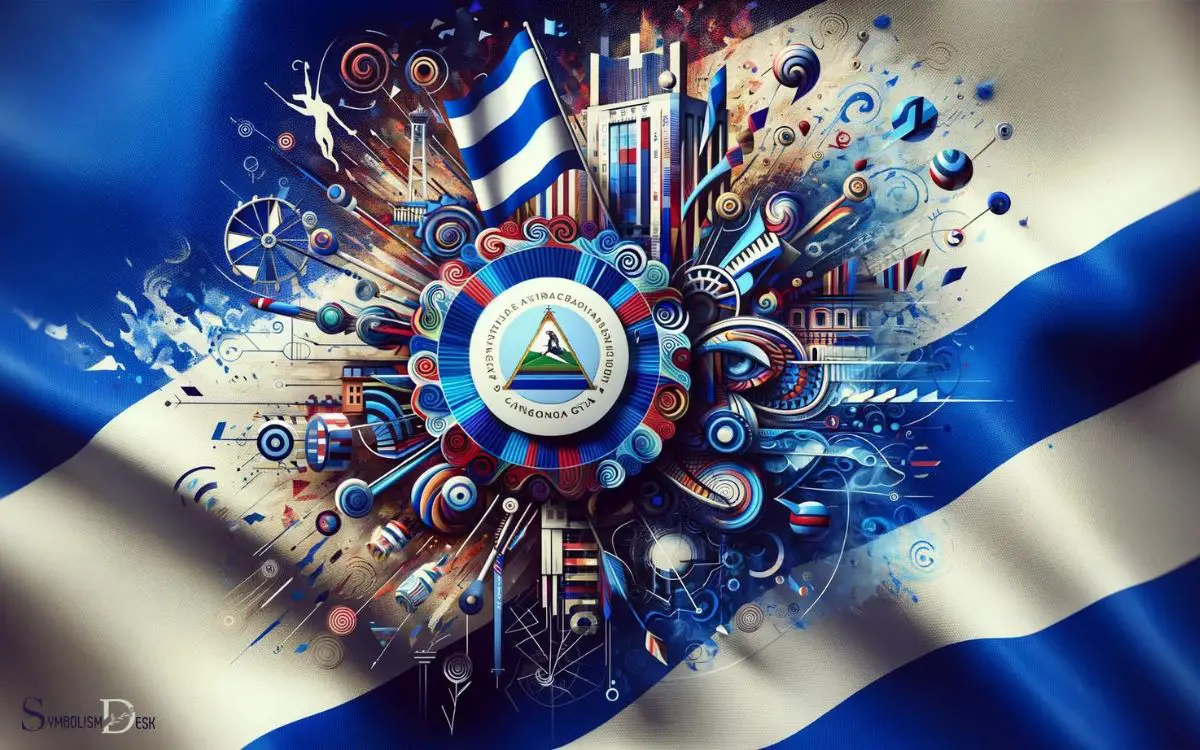
The symbol on the Nicaraguan flag embodies a profound influence on the nation’s collective identity, shaping the citizens’ sense of historical continuity and shared values.
The symbol, a combination of the country’s coat of arms, represents the country’s history, culture, and struggle for independence.
Its elements, such as the rainbow, the five volcanoes, and the Phrygian cap, reflect the nation’s diverse geography, its indigenous heritage, and the aspirations for freedom and sovereignty.
This powerful representation fosters a sense of unity and pride among Nicaraguans, reinforcing their connection to the nation’s past and present. The following table illustrates the key elements of the Nicaraguan flag symbol and their significance: The blue and white stripes on the flag represent the two oceans that border Nicaragua, the Pacific Ocean and the Caribbean Sea. The five volcanoes in the center of the flag symbolize the five members of the Central American Federation. The phrase ‘costa rica flag symbolism‘ refers to the elements of the Costa Rican flag and their significance, such as the red, white, and blue colors representing the blood shed for freedom, the peace that the country enjoys, and the clear sky above Costa Rica. These symbols serve to instill a sense of national pride and unity among Costa Ricans.
| Symbol | Meaning |
|---|---|
| Rainbow | Unity and peace among the country’s diverse population |
| Volcanoes | Strength and resilience of the Nicaraguan people |
| Phrygian cap | Struggle for freedom and sovereignty |
This strong connection to the symbol fosters a deep-rooted national identity and shapes the country’s cultural and historical narrative.
This profound influence continues to resonate in contemporary Nicaraguan society, impacting the flag’s recognition and usage.
Do the Symbols on National Flags Usually Represent Ideals or Concepts?
The symbolism of argentina’s flag is deeply rooted in its ideals and concepts as it carries meaning related to its history and national identity. The Sun of May emblem represents freedom, optimism, and the unity of the Argentine people. The colors, blue and white, symbolize the clear skies and purity, reflecting patriotism and peace. Overall, national flags usually incorporate symbols to convey ideals and concepts that hold significance for a country.
What Is the Significance of Symbols on Flags?
Symbols on the American flag carry immense significance. The thirteen stripes represent the original colonies, while the fifty stars depict each state in the union. These symbols on the American flag instill patriotism, unity, and pride among its citizens, reminding them of their country’s history, values, and aspirations. Whether it’s the stars or the stripes, the American flag stands tall as a powerful symbol of the nation’s past, present, and future.
Contemporary Use and Recognition
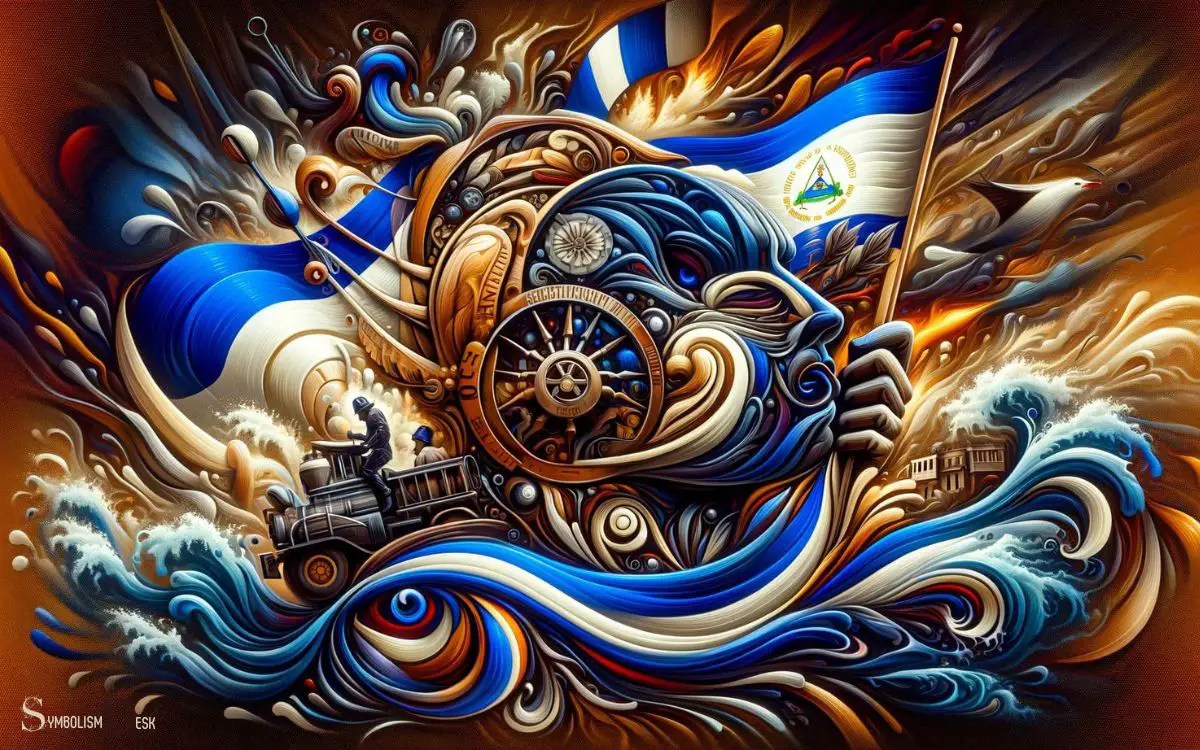
Contemporary recognition and use of the symbol on the Nicaraguan flag continues to play a significant role in the nation’s modern identity and cultural representation.
- The symbol is prominently displayed during national holidays, political events, and cultural celebrations, emphasizing its enduring significance in the country’s collective consciousness.
- It serves as a unifying emblem, fostering a sense of patriotism and belonging among Nicaraguans, both at home and abroad.
- The symbol is widely utilized in various forms of art, literature, and media, reflecting its pervasive influence in the contemporary cultural landscape of Nicaragua.
- Internationally, the symbol on the Nicaraguan flag serves as a powerful representation of the country, contributing to its visibility and recognition on the global stage.
Conclusion
The symbol on the Nicaraguan flag holds deep historical and cultural significance, reflecting the country’s heritage and values. Its evolution over time has shaped its impact on national identity and its contemporary use and recognition.
The symbol remains a powerful representation of Nicaraguan society, serving as a reminder of the nation’s rich history and the values it holds dear. Its enduring presence continues to shape the country’s identity and resonate with its people.

